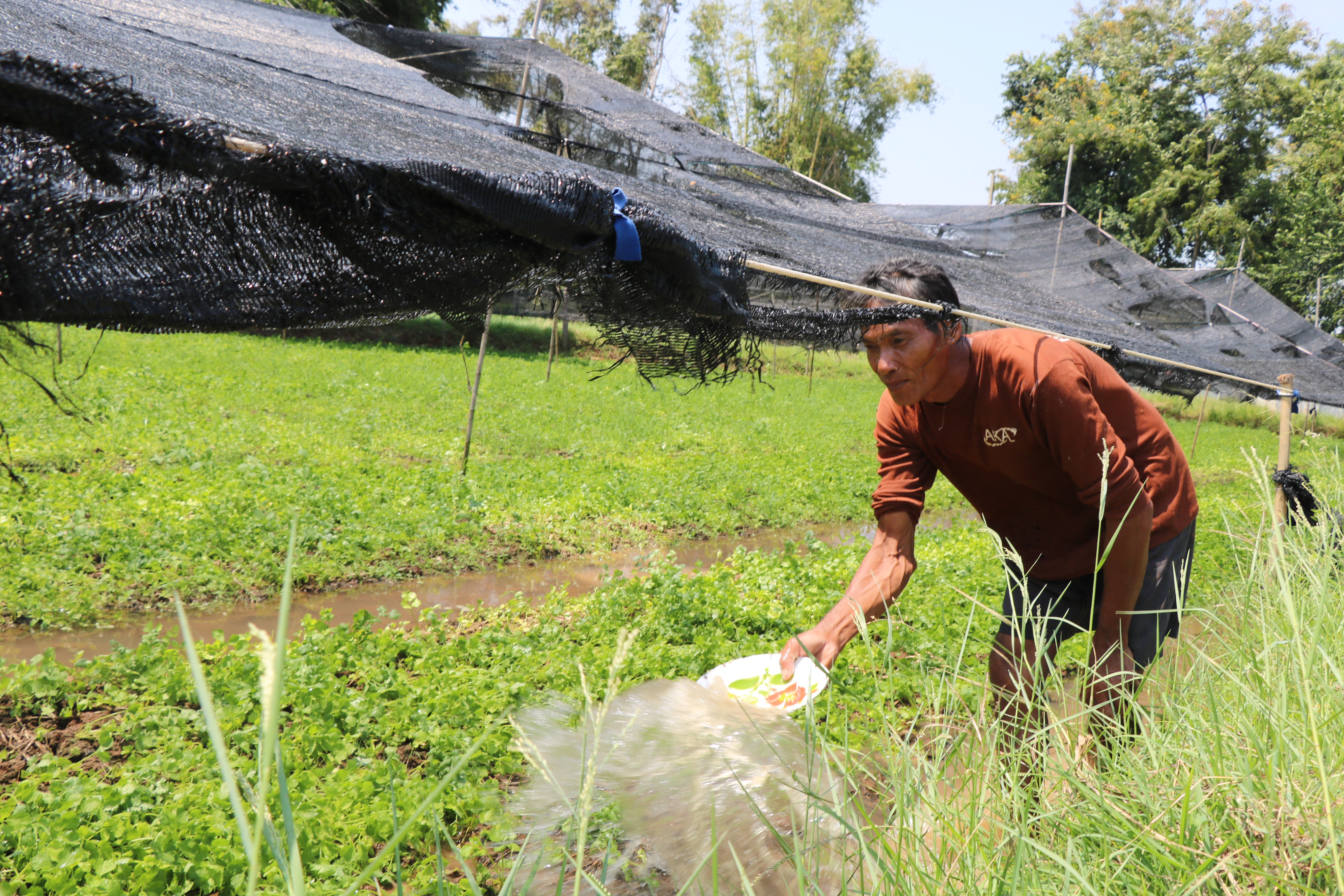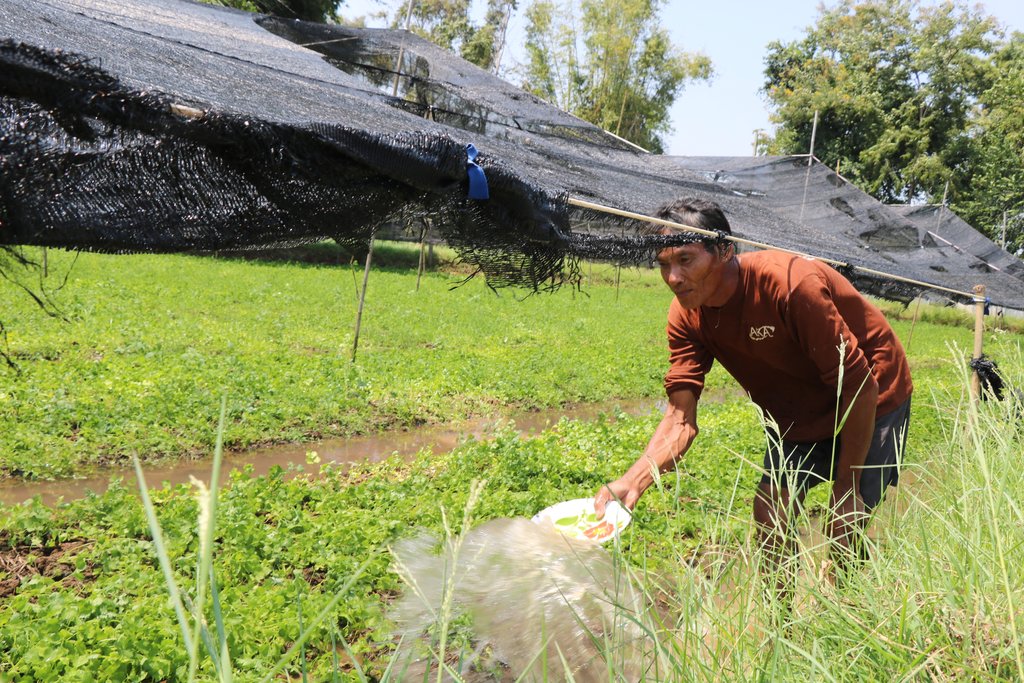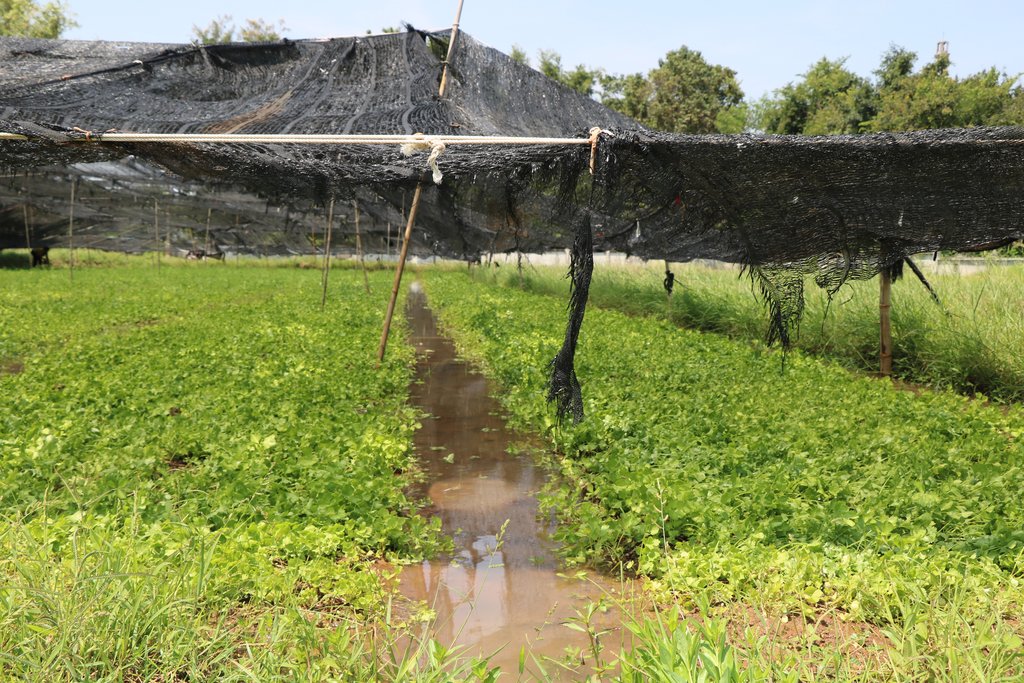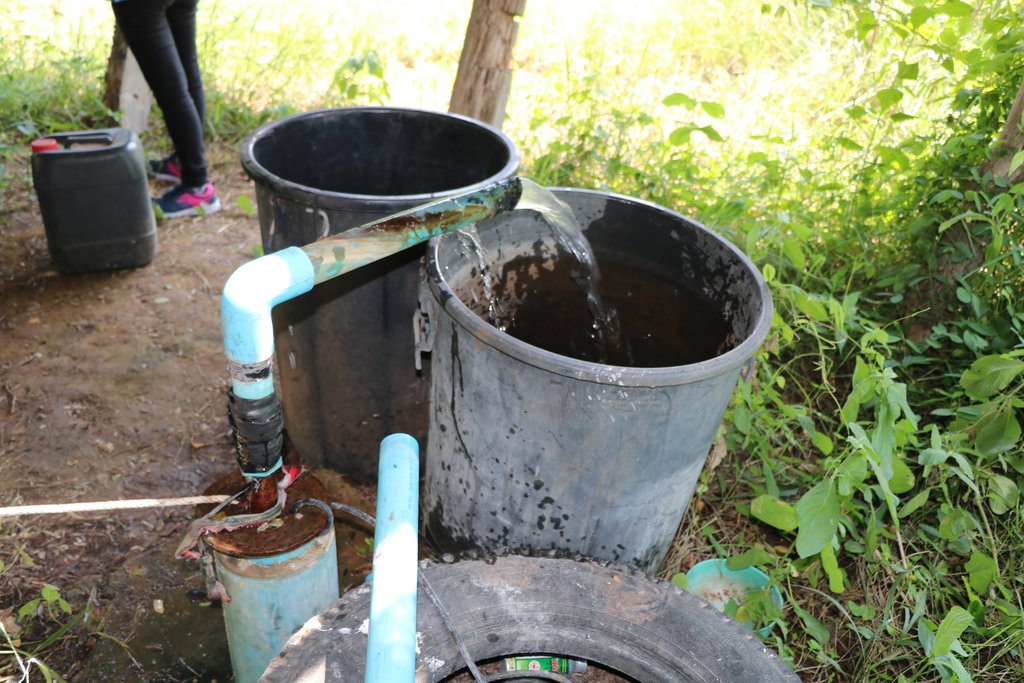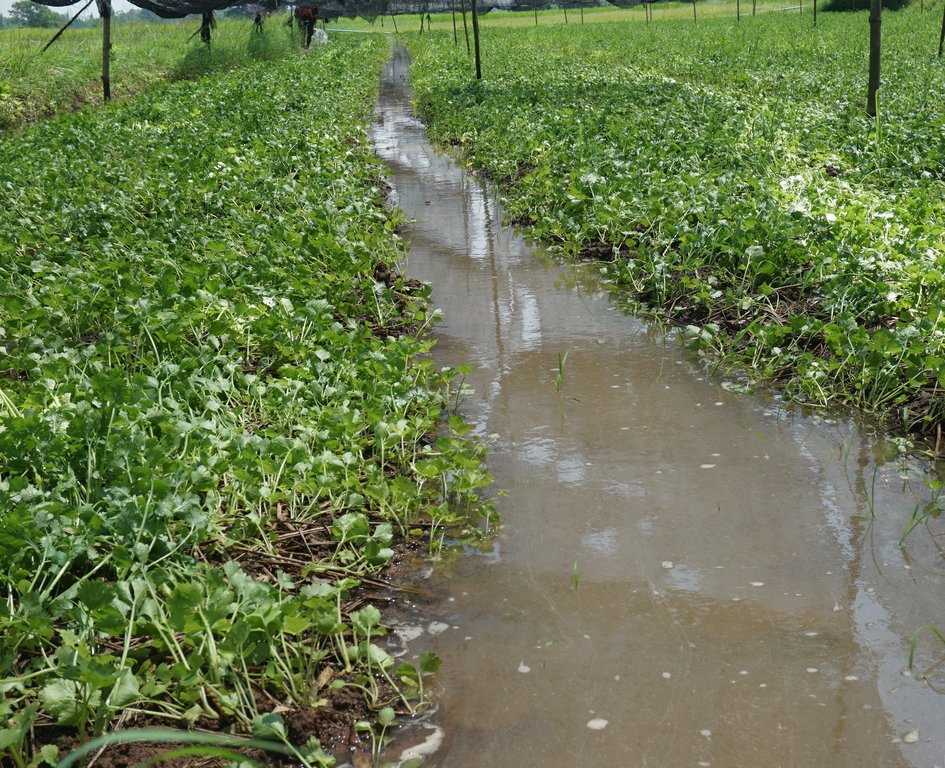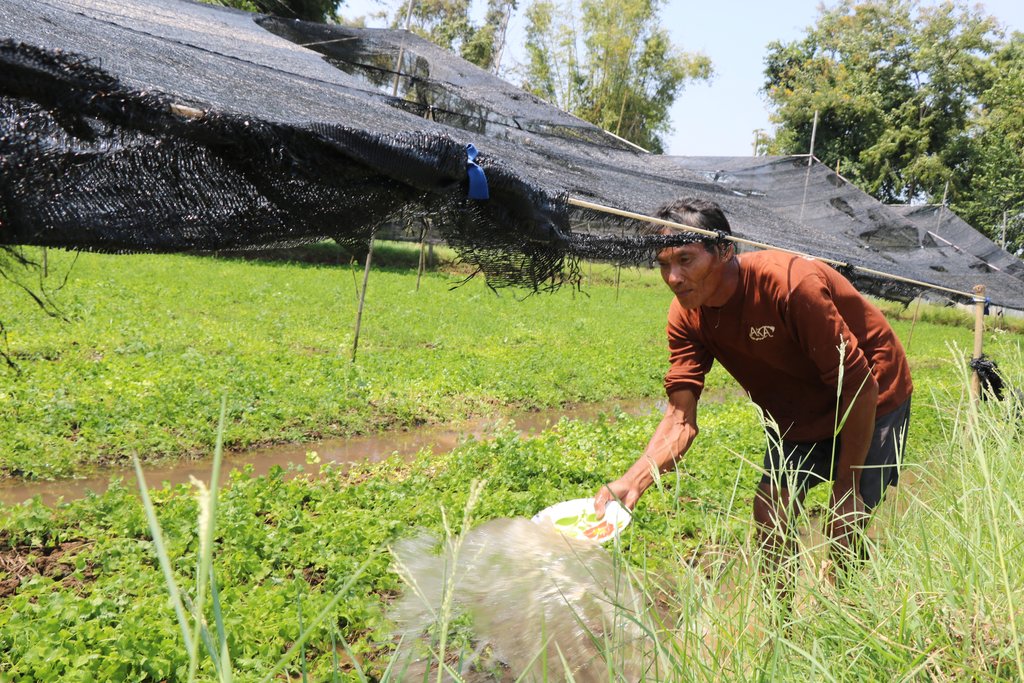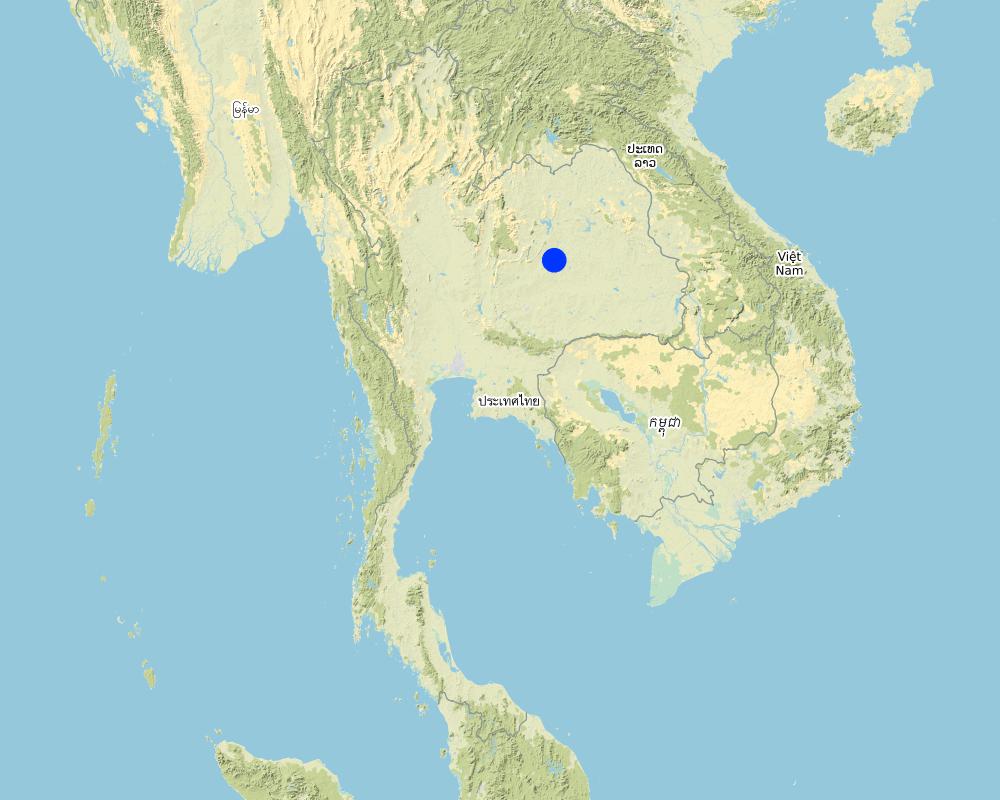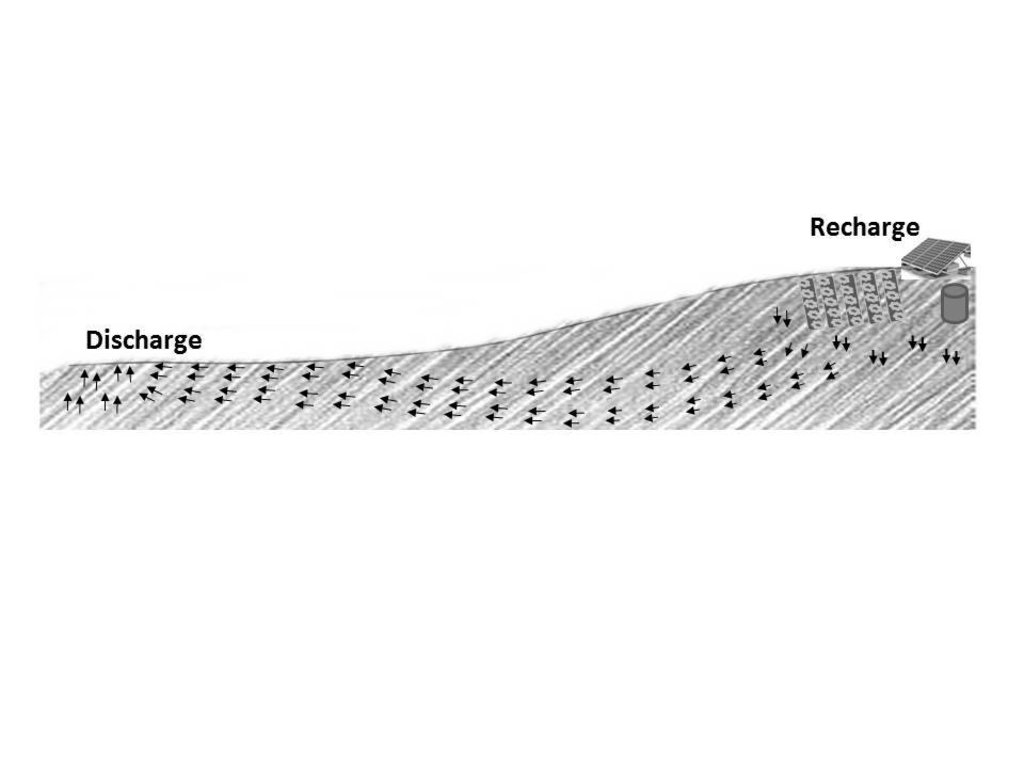Land Use Change from Rice to Vegetables [ไทย]
- ผู้สร้างสรรค์:
- การอัพเดท:
- ผู้รวบรวม: supranee sritumboon
- ผู้เรียบเรียง: –
- ผู้ตรวจสอบ: Samran Sombatpanit, Rima Mekdaschi Studer, William Critchley
Growing Vegetables
technologies_4161 - ไทย
ดูส่วนย่อย
ขยายทั้งหมด ย่อทั้งหมด1. ข้อมูลทั่วไป
1.2 รายละเอียดที่ติดต่อได้ของผู้รวบรวมและองค์กรที่เกี่ยวข้องในการประเมินและการจัดเตรียมทำเอกสารของเทคโนโลยี
วิทยากรหลัก
ผู้ใช้ที่ดิน:
Noithong Bualai
Farmer of Ban Kaonoi
ไทย
Volunteer soil doctor:
Sommakate Boonmee
Volunteer soil doctor who is a farmer in a community; he volunteers and collaborates with the Regional Office of Land Development Department.
ไทย
ผู้เชี่ยวชาญ SLM:
Rhophandung Weera
Land Development Department Region 5
ไทย
ผู้เชี่ยวชาญ SLM:
ผู้เชี่ยวชาญ SLM:
Phothinam Pornpana
Land Development Department Region 5
ไทย
ผู้เชี่ยวชาญ SLM:
Jakkarach Usa
Land Development Department Region 5
ไทย
ผู้เชี่ยวชาญ SLM:
Wangkaew Areerat
Land Development Department
ไทย
national consultant:
ชื่อของโครงการซึ่งอำนวยความสะดวกในการทำเอกสารหรือการประเมินเทคโนโลยี (ถ้าเกี่ยวข้อง)
Decision Support for Mainstreaming and Scaling out Sustainable Land Management (GEF-FAO / DS-SLM)ชื่อของโครงการซึ่งอำนวยความสะดวกในการทำเอกสารหรือการประเมินเทคโนโลยี (ถ้าเกี่ยวข้อง)
Book project: where people and their land are safer - A Compendium of Good Practices in Disaster Risk Reduction (DRR) (where people and their land are safer)ชื่อของโครงการซึ่งอำนวยความสะดวกในการทำเอกสารหรือการประเมินเทคโนโลยี (ถ้าเกี่ยวข้อง)
Book project: where the land is greener - Case Studies and Analysis of Soil and Water Conservation Initiatives Worldwide (where the land is greener)ชื่อขององค์กรซึ่งอำนวยความสะดวกในการทำเอกสารหรือการประเมินเทคโนโลยี (ถ้าเกี่ยวข้อง)
Land Development Department LDD (Land Development Department LDD) - ไทย1.3 เงื่อนไขการใช้ข้อมูลที่ได้บันทึกผ่านทาง WOCAT
ผู้รวบรวมและวิทยากรหลักยอมรับเงื่อนไขเกี่ยวกับการใช้ข้อมูลที่ถูกบันทึกผ่านทาง WOCAT:
ใช่
1.4 การเปิดเผยเรื่องความยั่งยืนของเทคโนโลยีที่ได้อธิบายไว้
เทคโนโลยีที่ได้อธิบายไว้นี้เป็นปัญหาของความเสื่อมโทรมโทรมของที่ดินหรือไม่ จึงไม่ได้รับการยอมรับว่าเป็นเทคโนโลยีเพื่อการจัดการที่ดินอย่างยั่งยืน:
ไม่ใช่
แสดงความคิดเห็น:
The alteration of an inappropriate area from rice to vegetables, with a pump well installed for irrigation. Farmers could rotate the vegetables with paddy rice.
2. การอธิบายลักษณะของเทคโนโลยี SLM
2.1 การอธิบายแบบสั้น ๆ ของเทคโนโลยี
คำจำกัดความของเทคโนโลยี:
Land use change from rice to vegetables was started by a group of farmers with the help of the LDD who provided irrigation from groundwater through a 28m deep bore hole. This enables the groundwater level to be lowered preventing salination in the discharge area lower down.
2.2 การอธิบายแบบละเอียดของเทคโนโลยี
คำอธิบาย:
Changing flooded rice to salt-tolerant vegetable production as recommended by LDD researchers was started 25 years ago by a group of farmers at Ban Kaonoi Village, Pueaiyai Sub-district, Non Sila District, Khon Kaen Province. The land is located in the recharge area, which is nonsaline, with groundwater that has a salinity level of 0.7 dS/m. Groundwater that moves downslope picks up salt - and deposits salt in low-lying areas, causing off-site salinization. The LDD supports the land use change from rice to vegetables for higher income while at the same time lowering groundwater levels. When rice is grown through flood irrigation the groundwater level rises. With vegetables, farmers try to use minimal amounts of water to prevent salt accumulation – a weekly rate of 90 m3/rai (560 m3/ hectare). The objectives of changing rice to vegetables are to (a) decrease water use (b) get higher incomes from growing salt-tolerant vegetables, and (c) prevent off-site salinization. Without a drainage system, the following slightly to moderately salt-tolerant vegetables are recommended: varieties of basil (Ocimum spp), celery (Apium graviolens) and coriander (Coriandrum sativum). Planting starts with land preparation and making beds 1 m wide and 0.3 m high, mixed with 500 kg/rai (3125 kg/hectare cow dung, with 0.3m wide irrigation furrows between the beds.
The vegetables are divided into two groups: long- and short-duration crops. Long-duration crops (e.g. basil) take 5 months before harvest. The first crop is planted mid-January and harvested at the end of May; the second crop is planted mid-July, and harvested mid-December. The short-duration crops of coriander and Chinese celery need a 75-80 day growing period. The first sowing starts late January/ February and harvest is mid-April; the second sowing is late July, with harvest early October. Only short-duration crops can be planted after the rice harvest in December or earlier. Maintenance includes weeding (by hand) and fertilizer application. Labour is required for supplementary irrigation - by spraying water on the leaves as required – and once a week irrigation is applied through the furrows. The costs and benefits are calculated; the costs include seed, fertilizer, and labour for land preparation, planting, irrigation, maintenance, and harvesting. The farmers favor the technology because the crops can grow well in such circumstances and the products meet the market’s demand. In such way, farmers get higher income compared with rice, while crop residues and weeds can be used as animal feed.
2.3 รูปภาพของเทคโนโลยี
คำอธิบายภาพ:
The images show the process of vegetable cultivation in a village that farmers developed from their experience.
2.4 วีดีโอของเทคโนโลยี
วันที่:
02/10/2018
สถานที่:
Ban Kaonoi
ชื่อผู้ถ่ายวีดีโอ:
Supranee Sritumboon
2.5 ประเทศภูมิภาค หรือสถานที่ตั้งที่เทคโนโลยีได้นำไปใช้และได้รับการครอบคลุมโดยการประเมินนี้
ประเทศ:
ไทย
ภูมิภาค/รัฐ/จังหวัด:
Northeast/Khon Kaen
ข้อมูลจำเพาะเพิ่มเติมของสถานที่ตั้ง :
Ban Kaonoi is in Non Sila Sub-district, Banphai District, Khon Kaen Province.
ระบุการกระจายตัวของเทคโนโลยี:
- กระจายไปอย่างสม่ำเสมอในพื้นที่
If precise area is not known, indicate approximate area covered:
- 1-10 ตร.กม.
Is/are the technology site(s) located in a permanently protected area?
ไม่ใช่
แสดงความคิดเห็น:
This technology is distributed in a paddy area with slight salinity, which is within a recharge area.
Map
×2.6 วันที่การดำเนินการ
ถ้าไม่รู้ปีที่แน่นอน ให้ระบุวันที่โดยประมาณ:
- 10-50 ปี
2.7 คำแนะนำของเทคโนโลยี
ให้ระบุว่าเทคโนโลยีถูกแนะนำเข้ามาอย่างไร:
- ด้วยการริเริ่มของผู้ใช้ที่ดินเอง
- ทางโครงการหรือจากภายนอก
- as part of a traditional system over 25 years
ความคิดเห็น (ประเภทของโครงการ เป็นต้น) :
Technology was developed by the farmers and disseminated in the area as a traditional system and then further developed and disseminated through the project by Land Development Department Region 5.
3. การจัดประเภทของเทคโนโลยี SLM
3.1 วัตถุประสงค์หลักของเทคโนโลยี
- ปรับปรุงการผลิตให้ดีขึ้น
- ปรับตัวเข้ากับการเปลี่ยนแปลงภูมิอากาศของโลก สภาพภูมิอากาศที่รุนแรงและผลกระทบ
- สร้างผลกระทบทางด้านเศรษฐกิจที่เป็นประโยชน์
3.2 ประเภทของการใช้ที่ดินในปัจจุบันที่ได้นำเทคโนโลยีไปใช้

พื้นที่ปลูกพืช
- การปลูกพืชล้มลุกอายุปีเดียว
Annual cropping - Specify crops:
- cereals - rice (wetland)
- paddy rice and vegetables
จำนวนของฤดูเพาะปลูกต่อปี:
- 3
ระบุ:
1 crop of paddy rice and 2 crops of vegetables but only in the lower level fields with a better water supply
Is crop rotation practiced?
ใช่
ถ้าใช่ ระบุ:
The vegetables as Apium gravcolens L., and Coriandrum sativum L. will be grown after rice harvesting.

ทางน้ำ แหล่งน้ำ พื้นที่ชุ่มน้ำ
- Pump well
ผลิตภัณฑ์หลักหรือบริการ:
Farmers use water from a pump well for vegetables; the well should not be deeper than 30 m.
แสดงความคิดเห็น:
Farmer constructed the pump well where they plant vegetables. Also, they can use the pump well for paddy rice in a drought year such as in 2018.
3.3 Has land use changed due to the implementation of the Technology?
Has land use changed due to the implementation of the Technology?
- Yes (Please fill out the questions below with regard to the land use before implementation of the Technology)
Land use mixed within the same land unit:
ไม่ใช่

พื้นที่ปลูกพืช
- การปลูกพืชล้มลุกอายุปีเดียว
- Paddy rice and vegetables (Ocimum basilicum L., Ocimum tenuiflorum L., Ocimum x africanum Lour.)
Is crop rotation practiced?
ใช่
ถ้าใช่ ระบุ:
Vegetables (Apium gravcolens L. and Coriandrum sativum L.) will be rotated with paddy rice.
แสดงความคิดเห็น:
Vegetables were mainly growing in some paddy areas in the uplands. Moreover, farmers will grow vegetables after rice harvesting in lowland fields.
3.4 การใช้น้ำ
การใช้น้ำของที่ดินที่มีการใช้เทคโนโลยีอยู่:
- น้ำฝนร่วมกับการชลประทาน
แสดงความคิดเห็น:
The area is under rainfed agriculture but farmers set up the pump well to support cultivation.
3.5 กลุ่ม SLM ที่ตรงกับเทคโนโลยีนี้
- ระบบหมุนเวียน (การปลูกพืชหมุนเวียน การพักดิน การเกษตรแบบไร่เลื่อนลอย)
- การจัดการปลูกพืชร่วมกับปศุสัตว์
- การจัดการน้ำบาดาล
3.6 มาตรการ SLM ที่ประกอบกันเป็นเทคโนโลยี

มาตรการจัดการพืช
- A1: พืช/สิ่งปกคลุมดิน
- A2: อินทรียวัตถุในดิน/ความอุดมสมบูรณ์ในดิน

มาตรการอนุรักษ์ด้วยโครงสร้าง
- S7: การกักเก็บน้ำ/การส่งลำเลียง/อุปกรณ์การชลประทาน

มาตรการอนุรักษ์ด้วยการจัดการ
- M6: การจัดการของเสีย (การทำ รีไซเคิล การเอากลับมาใช้ใหม่หรือการลดปริมาณ)
แสดงความคิดเห็น:
Farmers applied farmyard manure for soil improvement in the vegetable area. All or most households keep cattle so they have manure for such use.
3.7 รูปแบบหลักของการเสื่อมโทรมของที่ดินที่ได้รับการแก้ไขโดยเทคโนโลยี

การเสื่อมโทรมของดินทางด้านเคมี
- Cs (Salinization/alkalinization): การสะสมเกลือหรือการทำให้เป็นด่าง

การเสื่อมโทรมของดินทางด้านกายภาพ
- Pc (Compaction): การอัดแน่น
- Pk (Slaking and crusting): การอุดตันของช่องว่างในดินหรือรูพรุน

การเสื่อมโทรมของดินทางด้านชีวภาพ
- Bc (Reduction of vegetation cover): การลดลงของจำนวนพืชที่ปกคลุมดิน
- Bq (Quantity/biomass decline): การลดลงของปริมาณหรือมวลชีวภาพ
- Bl (Loss of soil life): การสูญเสียสิ่งมีชีวิตในดิน

การเสื่อมโทรมของน้ำ
- Hq (Decline of groundwater quality): การลดลงของคุณภาพน้ำบาดาล
แสดงความคิดเห็น:
The area where such technology is applied is located in a slightly saline and recharge zone.
3.8 การป้องกัน การลดลง หรือการฟื้นฟูความเสื่อมโทรมของที่ดิน
ระบุเป้าหมายของเทคโนโลยีกับความเสื่อมโทรมของที่ดิน:
- ลดความเสื่อมโทรมของดิน
- ปรับตัวกับสภาพความเสื่อมโทรมของที่ดิน
แสดงความคิดเห็น:
Reducing and adapting to land degradation and climate change.
4. ข้อมูลจำเพาะด้านเทคนิค กิจกรรมการนำไปปฏิบัติใช้ ปัจจัยนำเข้า และค่าใช้จ่าย
4.1 แบบแปลนทางเทคนิคของเทคโนโลยี
ข้อมูลจำเพาะด้านเทคนิค (แบบแปลนทางเทคนิคของเทคโนโลยี):
Schematic cross-section of groundwater flow from downward movement in the recharge zone with salt pick up along the pathway and salt deposit in the discharge area by upward movement.
4.2 ข้อมูลทั่วไปเกี่ยวกับการคำนวณปัจจัยนำเข้าและค่าใช้จ่าย
ให้ระบุว่าค่าใช้จ่ายและปัจจัยนำเข้าได้รับการคำนวณอย่างไร:
- ต่อพื้นที่ที่ใช้เทคโนโลยี
ระบุขนาดและหน่วยพื้นที่:
1 rai
If using a local area unit, indicate conversion factor to one hectare (e.g. 1 ha = 2.47 acres): 1 ha =:
1 ha = 6.25 rai
อื่นๆ หรือสกุลเงินประจำชาติ (ระบุ):
THB
If relevant, indicate exchange rate from USD to local currency (e.g. 1 USD = 79.9 Brazilian Real): 1 USD =:
32.0
ระบุค่าเฉลี่ยของค่าจ้างในการจ้างแรงงานต่อวัน:
300
4.3 กิจกรรมเพื่อการจัดตั้ง
| กิจกรรม | Timing (season) | |
|---|---|---|
| 1. | Drilling a pump well | May-July |
| 2. | Preparation of plots to produce vegetable seedlings | May-July |
| 3. | Vegetable planting | May-July |
| 4. | Fertilizer application | before planting |
4.4 ค่าใช้จ่ายของปัจจัยนำเข้าที่จำเป็นสำหรับการจัดตั้ง
| ปัจจัยนำเข้า | หน่วย | ปริมาณ | ค่าใช้จ่ายต่อหน่วย | ค่าใช้จ่ายทั้งหมดต่อปัจจัยนำเข้า | %ของค่าใช้จ่ายที่ก่อให้เกิดขึ้นโดยผู้ใช้ที่ดิน | |
|---|---|---|---|---|---|---|
| แรงงาน | Preparing vegetable garden | rai | 1.0 | 1200.0 | 1200.0 | |
| แรงงาน | Harvesting cost | person | 12.0 | 300.0 | 3600.0 | |
| วัสดุด้านพืช | Parsley seeds | gram | 300.0 | 0.183 | 54.9 | |
| วัสดุด้านพืช | Celery seeds | gram | 400.0 | 1.375 | 550.0 | |
| วัสดุด้านพืช | Sweet basil seeds | gram | 800.0 | 0.25 | 200.0 | |
| ปุ๋ยและสารฆ่า/ยับยั้งการเจริญเติบโตของสิ่งมีชีวิต (ไบโอไซด์) | Compost 1.25 THB/kg, application rate 1,000 kg/rai | time | 1.0 | 1252.0 | 1252.0 | |
| ปุ๋ยและสารฆ่า/ยับยั้งการเจริญเติบโตของสิ่งมีชีวิต (ไบโอไซด์) | Urea fertilizer 12 THB/kg, application rate 50 kg/rai | time | 1.0 | 600.0 | 600.0 | |
| ค่าใช้จ่ายทั้งหมดของการจัดตั้งเทคโนโลยี | 7456.9 | |||||
| Total costs for establishment of the Technology in USD | 233.03 | |||||
ถ้าผู้ใช้ที่ดินรับภาระน้อยกว่า 100% ของค่าใช้จ่าย ให้ระบุว่าใครเป็นผู้รับผิดชอบส่วนที่เหลือ:
Land Development Department
แสดงความคิดเห็น:
Note: where a well is dug the cost is USD 310 (approx)
4.5 การบำรุงรักษาสภาพหรือกิจกรรมที่เกิดขึ้นเป็นประจำ
| กิจกรรม | ช่วงระยะเวลา/ความถี่ | |
|---|---|---|
| 1. | Fertilizer application | 2 times/crop |
| 2. | Irrigation for parsley and celery | 90 days/crop |
| 3. | Irrigation for sweet basil | 180 days/crop |
4.6 ค่าใช้จ่ายของปัจจัยนำเข้าและกิจกรรมที่เกิดขึ้นเป็นประจำที่ต้องการการบำรุงรักษา (ต่อปี)
| ปัจจัยนำเข้า | หน่วย | ปริมาณ | ค่าใช้จ่ายต่อหน่วย | ค่าใช้จ่ายทั้งหมดต่อปัจจัยนำเข้า | %ของค่าใช้จ่ายที่ก่อให้เกิดขึ้นโดยผู้ใช้ที่ดิน | |
|---|---|---|---|---|---|---|
| แรงงาน | Irrigation for parsley and celery | day | 16.875 | 300.0 | 5062.5 | |
| แรงงาน | Irrigation for sweet basil | day | 11.25 | 300.0 | 3375.0 | |
| ปุ๋ยและสารฆ่า/ยับยั้งการเจริญเติบโตของสิ่งมีชีวิต (ไบโอไซด์) | Urea fertilizer 12 THB/kg, application rate 25 kg/rai | time | 5.0 | 300.0 | 1500.0 | |
| ค่าใช้จ่ายทั้งหมดของการบำรุงรักษาสภาพเทคโนโลยี | 9937.5 | |||||
| Total costs for maintenance of the Technology in USD | 310.55 | |||||
4.7 ปัจจัยสำคัญที่สุดที่มีผลกระทบต่อค่าใช้จ่าย
ปัจจัยสำคัญที่สุดที่มีผลกระทบต่อค่าใช้จ่ายต่างๆ:
Drilling a pump well because water is the most important factor for the production.
5. สิ่งแวดล้อมทางธรรมชาติและของมนุษย์
5.1 ภูมิอากาศ
ฝนประจำปี
- < 250 ม.ม.
- 251-500 ม.ม.
- 501-750 ม.ม.
- 751-1,000 ม.ม.
- 1,001-1,500 ม.ม.
- 1,501-2,000 ม.ม.
- 2,001-3,000 ม.ม.
- 3,001-4,000 ม.ม.
- > 4,000 ม.ม.
ระบุปริมาณน้ำฝนเฉลี่ยรายปี (ถ้ารู้) :หน่วย ม.ม.
1200.00
ระบุชื่อของสถานีตรวดวัดอากาศที่ใช้อ้างอิงคือ:
Upper Northeastern Meteorological Center
เขตภูมิอากาศเกษตร
- ชื้น
5.2 สภาพภูมิประเทศ
ค่าเฉลี่ยความลาดชัน:
- ราบเรียบ (0-2%)
- ลาดที่ไม่ชัน (3-5%)
- ปานกลาง (6-10%)
- เป็นลูกคลื่น (11-15%)
- เป็นเนิน (16-30%)
- ชัน (31-60%)
- ชันมาก (>60%)
ธรณีสัณฐาน:
- ที่ราบสูง/ที่ราบ
- สันเขา
- ไหล่เขา
- ไหล่เนินเขา
- ตีนเนิน
- หุบเขา
ระดับความสูง:
- 0-100 เมตร
- 101-500 เมตร
- 501-1,000 เมตร
- 1,001-1,500 เมตร
- 1,501-2,000 เมตร
- 2,001-2,500 เมตร
- 2,501-3,000 เมตร
- 3,001-4,000 เมตร
- > 4,000 เมตร
ให้ระบุถ้าเทคโนโลยีได้ถูกนำไปใช้:
- ไม่เกี่ยวข้อง
5.3 ดิน
ค่าเฉลี่ยความลึกของดิน:
- ตื้นมาก (0-20 ซ.ม.)
- ตื้น (21-50 ซ.ม.)
- ลึกปานกลาง (51-80 ซ.ม.)
- ลึก (81-120 ซ.ม.)
- ลึกมาก (>120 ซ.ม.)
เนื้อดิน (ดินชั้นบน):
- ละเอียด/หนัก (ดินเหนียว)
เนื้อดินล่าง (> 20 ซ.ม.ต่ำจากผิวดิน):
- ละเอียด/หนัก (ดินเหนียว)
อินทรียวัตถุในดิน:
- ต่ำ (<1%)
5.4 ความเป็นประโยชน์และคุณภาพของน้ำ
ระดับน้ำใต้ดิน:
5-50 เมตร
น้ำไหลบ่าที่ผิวดิน:
ปานกลาง
คุณภาพน้ำ (ที่ยังไม่ได้บำบัด):
เป็นน้ำใช้เพื่อการเกษตรเท่านั้น (การชลประทาน)
Water quality refers to:
both ground and surface water
ความเค็มของน้ำเป็นปัญหาหรือไม่:
ใช่
กำลังเกิดน้ำท่วมในพื้นที่หรือไม่:
ไม่ใช่
5.5 ความหลากหลายทางชีวภาพ
ความหลากหลายทางชนิดพันธุ์:
- ปานกลาง
ความหลากหลายของแหล่งที่อยู่:
- ปานกลาง
5.6 ลักษณะของผู้ใช้ที่ดินที่นำเทคโนโลยีไปปฏิบัติใช้
อยู่กับที่หรือเร่ร่อน:
- อยู่กับที่
แนวทางการตลาดของระบบการผลิต:
- ทำการค้า/การตลาด
รายได้ที่มาจากนอกฟาร์ม:
- < 10% ของรายได้ทั้งหมด
ระดับของความมั่งคั่งโดยเปรียบเทียบ:
- รวย
เป็นรายบุคคล/ครัวเรือน:
- กลุ่ม/ชุมชน
ระดับของการใช้เครื่องจักรกล:
- งานที่ใช้แรงกาย
- การใช้เครื่องจักรหรือเครื่องยนต์
เพศ:
- หญิง
- ชาย
อายุของผู้ใช้ที่ดิน:
- วัยกลางคน
- ผู้สูงอายุ
5.7 Average area of land used by land users applying the Technology
- < 0.5 เฮกตาร์
- 0.5-1 เฮกตาร์
- 1-2 เฮกตาร์
- 2-5 เฮกตาร์
- 5-15 เฮกตาร์
- 15-50 เฮกตาร์
- 50-100 เฮกตาร์
- 100-500 เฮกตาร์
- 500-1,000 เฮกตาร์
- 1,000-10,000 เฮกตาร์
- >10,000 เฮกตาร์
พิจารณาว่าเป็นขนาดเล็ก กลาง หรือขนาดใหญ่ (ซึ่งอ้างอิงถึงบริบทระดับท้องถิ่น):
- ขนาดกลาง
5.8 กรรมสิทธิ์ในที่ดิน สิทธิในการใช้ที่ดินและสิทธิในการใช้น้ำ
กรรมสิทธิ์ในที่ดิน:
- รายบุคคล ได้รับสิทธิครอบครอง
สิทธิในการใช้ที่ดิน:
- เข้าถึงได้แบบเปิด (ไม่ได้จัดระเบียบ)
สิทธิในการใช้น้ำ:
- เข้าถึงได้แบบเปิด (ไม่ได้จัดระเบียบ)
Are land use rights based on a traditional legal system?
ใช่
5.9 การเข้าถึงบริการและโครงสร้างพื้นฐาน
สุขภาพ:
- จน
- ปานกลาง
- ดี
การศึกษา:
- จน
- ปานกลาง
- ดี
ความช่วยเหลือทางด้านเทคนิค:
- จน
- ปานกลาง
- ดี
การจ้างงาน (เช่น ภายนอกฟาร์ม):
- จน
- ปานกลาง
- ดี
ตลาด:
- จน
- ปานกลาง
- ดี
พลังงาน:
- จน
- ปานกลาง
- ดี
ถนนและการขนส่ง:
- จน
- ปานกลาง
- ดี
น้ำดื่มและการสุขาภิบาล:
- จน
- ปานกลาง
- ดี
บริการด้านการเงิน:
- จน
- ปานกลาง
- ดี
6. ผลกระทบและสรุปคำบอกกล่าว
6.1 ผลกระทบในพื้นที่ดำเนินการ (On-site) จากการใช้เทคโนโลยี
ผลกระทบทางด้านเศรษฐกิจและสังคม
การผลิต
การผลิตพืชผล
แสดงความคิดเห็น/ระบุ:
An increase in production because the famers get greater yields and have more diversified crops.
คุณภาพพืชผล
ความหลากหลายของผลิตภัณฑ์
พื้นที่สำหรับการผลิต
การจัดการที่ดิน
ความเป็นประโยชน์และคุณภาพของน้ำ
การมีน้ำดื่มไว้ให้ใช้
แสดงความคิดเห็น/ระบุ:
Water for livestock and irrigation increases - but no difference to drinking water
คุณภาพน้ำดื่ม
การมีน้ำไว้ให้ปศุสัตว์
การมีน้ำไว้ให้สำหรับการชลประทาน
คุณภาพน้ำสำหรับการชลประทาน
รายได้และค่าใช้จ่าย
รายได้จากฟาร์ม
แสดงความคิดเห็น/ระบุ:
Large increase because of more water availability for irrigation.
ความหลากหลายของแหล่งผลิตรายได้
ผลกระทบด้านสังคมวัฒนธรรมอื่น ๆ
ความมั่นคงด้านอาหาร / พึ่งตนเองได้
สถานการณ์ด้านสุขภาพ
SLM หรือความรู้เรื่องความเสื่อมโทรมของที่ดิน
ผลกระทบด้านนิเวศวิทยา
วัฐจักรน้ำหรือน้ำบ่า
ปริมาณน้ำ
คุณภาพน้ำ
ดิน
ความชื้นในดิน
สิ่งปกคลุมดิน
การหมุนเวียนและการเติมของธาตุอาหาร
ความเค็ม
ความหลากหลายทางชีวภาพของพืชและสัตว์
การปกคลุมด้วยพืช
ความหลากหลายทางชีวภาพของพืช
ความหลากหลายทางชีวภาพของสัตว์
ลดความเสี่ยงของภัยพิบัติ
ผลกระทบจากภัยแล้ง
6.2 ผลกระทบนอกพื้นที่ดำเนินการ (Off-site) จากการใช้เทคโนโลยี
น้ำที่ใช้ประโยชน์ได้
6.3 การเผชิญและความตอบสนองของเทคโนโลยีต่อการเปลี่ยนแปลงสภาพภูมิอากาศที่ค่อยเป็นค่อยไป และสภาพรุนแรงของภูมิอากาศ / ภัยพิบัติ (ที่รับรู้ได้โดยผู้ใช้ที่ดิน)
การเปลี่ยนแปลงสภาพภูมิอากาศที่ค่อยเป็นค่อยไป
การเปลี่ยนแปลงสภาพภูมิอากาศที่ค่อยเป็นค่อยไป
| ฤดู | increase or decrease | เทคโนโลยีมีวิธีการรับมืออย่างไร | |
|---|---|---|---|
| อุณหภูมิประจำปี | ลดลง | ดี | |
| ฝนประจำปี | เพิ่มขึ้น | ดี |
สภาพรุนแรงของภูมิอากาศ (ภัยพิบัติ)
ภัยพิบัติจากสภาพภูมิอากาศ
| เทคโนโลยีมีวิธีการรับมืออย่างไร | |
|---|---|
| ภัยจากฝนแล้ง | ดี |
6.4 การวิเคราะห์ค่าใช้จ่ายและผลประโยชน์ที่ได้รับ
ผลประโยชน์ที่ได้รับเปรียบเทียบกับค่าใช้จ่ายในการจัดตั้งเป็นอย่างไร (จากมุมมองของผู้ใช้ที่ดิน)
ผลตอบแทนระยะสั้น:
ด้านบวก
ผลตอบแทนระยะยาว:
ด้านบวกอย่างมาก
ผลประโยชน์ที่ได้รับเปรียบเทียบกับค่าใช้จ่ายในการบำรุงรักษาหรือต้นทุนที่เกิดขึ้นซ้ำอีก เป็นอย่างไร (จากมุมมองของผู้ใช้ที่ดิน)
ผลตอบแทนระยะสั้น:
ด้านบวก
ผลตอบแทนระยะยาว:
ด้านบวกอย่างมาก
6.5 การปรับตัวของเทคโนโลยี
- > 50%
Of all those who have adopted the Technology, how many did so spontaneously, i.e. without receiving any material incentives/ payments?
- 51-90%
6.6 การปรับตัว
เทคโนโลยีได้รับการปรับเปลี่ยนเมื่อเร็วๆนี้ เพื่อให้ปรับตัวเข้ากับสภาพที่กำลังเปลี่ยนแปลงหรือไม่:
ใช่
ถ้าตอบว่าใช่ ให้ระบุว่าเงื่อนไขการเปลี่ยนแปลงใดที่ถูกปรับตัว:
- การมีแรงงานไว้ให้ใช้ (เนื่องจากการอพยพย้ายถิ่นฐาน)
6.7 จุดแข็ง / ข้อได้เปรียบ / โอกาสของเทคโนโลยี
| จุดแข็ง / ข้อได้เปรียบ / โอกาสในทัศนคติของผู้ใช้ที่ดิน |
|---|
| Get higher income from land use change from rice to vegetables. |
| Decrease water use compared to rice cultivation. |
| จุดแข็ง / ข้อได้เปรียบ / โอกาสในทัศนคติของผู้รวบรวมหรือวิทยากรหลัก |
|---|
| Lowering groundwater level. |
| Increasing farmer income. |
| Prevents salination at the discharged low-lying area. |
6.8 จุดอ่อน / ข้อเสียเปรียบ / ความเสี่ยงของเทคโนโลยีและวิธีการแก้ไข
| จุดอ่อน / ข้อเสียเปรียบ / ความเสี่ยงในทัศนคติของผู้ใช้ที่ดิน | มีวิธีการแก้ไขได้อย่างไร |
|---|---|
| Farmers need to find the market by themselves. | Expanding the vegetable plantation area will draw merchants to come and buy in the community. |
| จุดอ่อน / ข้อเสียเปรียบ / ความเสี่ยงในทัศนคติของผู้รวบรวมหรือวิทยากรหลัก | มีวิธีการแก้ไขได้อย่างไร |
|---|---|
| Some farmers prefer rice cultivation to growing vegetables. | Provide more information on land use change and create understanding of salination effects by the farmer. |
7. การอ้างอิงและการเชื่อมต่อ
7.1 วิธีการและแหล่งข้อมูล
- ไปเยี่ยมชมภาคสนาม การสำรวจพื้นที่ภาคสนาม
Visit 2 land user's land
- การสัมภาษณ์กับผู้ใช้ที่ดิน
Interview with group of 7 farmers
- การสัมภาษณ์ผู้เชี่ยวชาญด้าน SLM หรือผู้ชำนาญ
A Land Development Department officer
7.2 การอ้างอิงถึงสิ่งตีพิมพ์
หัวข้อ, ผู้เขียน, ปี, หมายเลข ISBN:
Land Development Department
ชื่อเรื่อง ผู้เขียน ปี ISBN:
http://www.ldd.go.th/
7.3 Links to relevant online information
ชื่อเรื่องหรือคำอธิบาย:
where the land is greener - Case Studies and Analysis of Soil and Water Conservation Initiatives Worldwide
URL:
https://www.wocat.net/library/media/27/
ชื่อเรื่องหรือคำอธิบาย:
where people and their land are safer - A Compendium of Good Practices in Disaster Risk Reduction (DRR) (where people and their land are safer)
URL:
https://www.wocat.net/en/projects-and-countries/projects/drr
7.4 General comments
The questionnaire is very complicated.
ลิงก์และโมดูล
ขยายทั้งหมด ย่อทั้งหมดลิงก์
ไม่มีลิงก์
โมดูล
ไม่มีโมดูล


